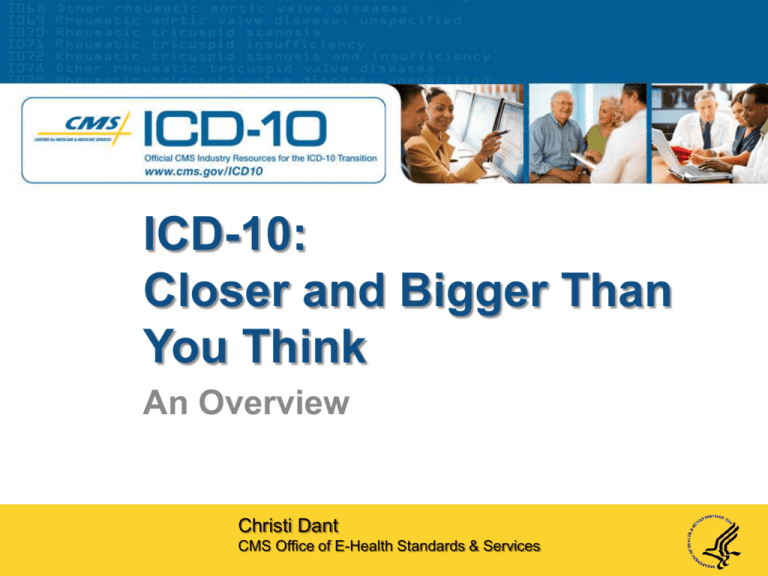ICD-10
advertisement

ICD-10: Closer and Bigger Than You Think An Overview Christi Dant CMS Office of E-Health Standards & Services Topics To Be Covered • • • • • What exactly is changing? Why the change? Getting ready Some of the major challenges Resources and suggestions to help you prepare What Is Changing? • First, HIPAA standards for electronic transactions must be upgraded to Version 4010/4010A Version 5010 • Medical diagnosis and inpatient procedure code sets: – ICD-9 CM ICD-10 CM ICD-10 PCS ICD-10 • Refers to the diagnosis and procedure code sets • Replaces ICD-9 code sets and includes updated medical terminology and classification of diseases. • More logically organized, more detailed and specific, and more clinically accurate Who Is Affected? Anyone who is covered by HIPAA: • Health care providers that conduct electronic transactions • Payers including Medicaid and Medicare • Clearinghouses Many non-HIPAA covered entities use ICD-9 codes: – – – – Vendors and business associates of covered entities Worker’s compensation programs Life insurance companies Researchers, epidemiologists, statisticians Why the change? • ICD-10 provides more specific data than ICD-9 – Better reflects current medical practice – Allow addition of new codes • The current coding system is running out of capacity – Expanded data capture • • • • • • Quality measurement Reduce coding errors Better analysis of disease patterns Track and respond to public health outbreaks Make claim submission more efficient Identify fraud and abuse More on ICD-10 • ICD-10 CM/PCS consists of two parts: – ICD-10-CM for diagnosis coding in all health care settings • Describes left vs. right, initial vs. subsequent encounter, routine vs. delayed healing, and nonunion vs. malunion – ICD-10-PCS for inpatient procedure coding in hospital settings • Provides detailed information on procedures and distinct codes for all types of devices • CPT coding for outpatient and office procedures is not affected by the ICD-10 transition October 1, 2013 The Federal Health Enterprise faces an unprecedented challenge. Payer (CMS / IHS / VA / DoD) Direct Provider (IHS, VA, DoD, NIH) Funder (HRSA / CDC) Policy Research, Historical Data and Surveillance/Epidemiology ICD-10 Will Affect Everything • From physicians to nurses, to the lab and front desk, everyone will need to understand and prepare for the transition – More, and more robust codes. Codes will grow from 17,000 to 140,000. – Updated policies and procedures. Any office policy or procedure tied to a diagnosis code, disease management, registries, or tracking must be changed – Medical record documentation. ICD-10 codes will better reflect the specificity already inherent in the patient's medical record. Benefits of ICD-10 • More accurate payments for new procedures • Fewer miscoded, rejected, and improper reimbursement claims • Improved ability to measure healthcare services • Increased sensitivity when refining grouping and reimbursement methodologies • Decreased need to include supporting documentation with claims Now Is the Time to Prepare • Version 5010 and ICD-10 transitions require business and systems changes throughout the health care industry. • Organizations need to have plans and budgets in place to address the potential for rejected claims and delays in reimbursement. Transitioning to ICD-10 • Identify your current systems and processes that use ICD-9 codes and what needs to be changed in the work flow. • Budget for time and money related to the implementation and loss of productivity. • Communicate implementation plans between providers, payers and vendors. • Allow enough time to test transactions. • Assess and plan for staff training needs. Biggest Challenges • Lack of full comprehension of the scope and complexity of necessary changes. – Significant Blind Spots remain (ubiquity of ICD-9 code applications; impacts on research/historical data) – Competing priorities – There is no road map. • Limited resources – financial, technical & contractual – Grow Your Own SMEs – Competition for vendors/contractors will be intense. When Do I Need to Be Ready? Remember These Dates Date Action January 1, 2011 External Version 5010 Testing January 1, 2012 Full Implementation of Version 5010 April 1, 2013 Recommend Start for Training Staff on ICD-10 Full Implementation of ICD-10 October 1, 2013 What Can Be Done Now? • Active engagement and participation in your ICD-10 steering committee. REMEMBER: THIS IS NOT AN IT PROJECT! • Learn more about ICD-10 and embrace how it can improve your operations and outcomes. • Lift every rock and peer underneath. Look for ICD-9 codes and its derivative data everywhere and consider who/how to address it. REMEMBER: THIS IS NOT JUST AN IT PROJECT! • Start now to enhance clinical documentation to align with ICD-10 and build staff competencies in anatomy and biomedical terminologies. Resources to Help You Prepare • CMS ICD-10 Web site: http://cms.gov/ICD10 • CMS ICD-10 Listserv: http://cms.gov/ICD10/02d_CMS_ICD10_Industry_Email_Updates.asp • Professional, clinical, trade associations Readily Available CMS Resources More from CMS Industry & Associations Step Up – One Example Training for ICD-10 Suggested training curriculum: Basic Understanding of the ICD-10 Code Set Coding for Diagnoses and Inpatient Hospital Procedures Anatomy & biomedical terminology refreshers (especially for coding staff) Using Systems Updated for ICD-10 Workflow changes In Closing Request that you all serve as ICD-10 Ambassadors and identify and share best practices. We can all get there together. QUESTIONS? Christi Dant Office of E-Health Standards & Services Centers for Medicare & Medicaid Services 410-786-5306 christi.dant@cms.hhs.gov




